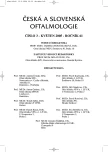Congenital Stationary Night Blindness (CSNB) – a Case Report
Authors:
D. Liláková; J. Svěrák; D. Hejcmanová
Authors‘ workplace:
Oční klinika FN, Hradec Králové
přednosta prof. MUDr. P. Rozsíval, CSc.
Published in:
Čes. a slov. Oftal., 61, 2005, No. 3, p. 218-223
Overview
Purpose:
To document occurrence of the congenital stationary night blindness type Schubert-Bornschein in some members of one family, to put together the family tree, and to evaluate the examination methods. Among others the electroretinogram (ERG) is substantial in the diagnosis of the disease and to distinguish different types of CSNB.
In the affected family, only in men the disease is expressed, females are transmitters. This corresponds to the X-linked inheritance. Simultaneously with CSNB, in this family, high myopia occurs not only in men, but also in women.
Conclusion:
CSNB is an inherited disease, mostly with X-linked inheritance. Affected are predominantly males, females are transmitters. This disease is not possible to treat. Despite this, to determine proper diagnosis is important and use of ERG is mandatory.
Key words:
congenital stationary night blindness, electroretinography, hemeralopia
Labels
OphthalmologyArticle was published in
Czech and Slovak Ophthalmology

2005 Issue 3
Most read in this issue
- Terson’s Syndrome, Pars Plana Vitrectomy and Anatomical and Functional Outcome
- Congenital Stationary Night Blindness (CSNB) – a Case Report
- Spontaneous Late Subluxation of Capsule, Intraocular Lens and Capsular Ring in Patient with Pseudoexfoliation Syndrome – a Case Report
- Perforating Pars Plana Sclerotomy in Idiopathic Uveal Effusion Syndrome
